The Certificate in Health Informatics is designed for new initiates
Contents |
Study online, at your own pace, for free – you only pay a fee to take the exam.
The CHI program starts with a ‘high level view of the lay of the land’ – HI101 (2 course modules).
This is followed with a program that offers a little more substance to some of the more important topic areas – HI201 (4 course modules).
And terminates after the completion of three specifically chosen course topics at the third level – HI203.
Don’t expect to cover all health informatics subject matter in great detail from just these introductory courses, but you will acquire a worthwhile briefing of what you need to know and you’ll become aware of how in-depth you next need to go!
If the term Health Informatics is new to you then take a look at this page – What is Health Informatics?
You will cover the following subject matter in HIC’s accredited Certificate in Health Informatics (CHI) program:
HI101 Essentials
HI101-01: Health Information Management
- Reforming Healthcare – the context
- Data and Information – an historical perspective
- Data, Information and Knowledge
- Medical Records
- Electronic Records
- Uses and Abuses of Personal Information
- Information Privacy – ethics and law
- Secondary Uses of Records
- Knowledge and Artificial Intelligence
- Patients and Information
- Visions of the Future
A basic introduction to the topic of health information management. Information is the cornerstone of almost all successful human endeavours and as a consequence they all rely heavily on information management in order to function effectively and efficiently.
HI101-02: Information Management Systems
- Representing Information for Computers
- File Compatibility
- Computer Systems
- The Hardware
- Input / Output
- Storage and Memory
- Processing
- The Software
- Operating System
- Applications
- Files and File Storage
- Compression of Data / Files
- Bugs
- Plugs, Ports and Peripherals
- System Performance
- Networks
This brief introduction to the basics of computerised information management systems will walk the reader through issues of hardware, software operating systems and applications, networks and communications. A basic understanding of these issues is of considerable advantage in understanding much of the content of the other modules of the Health Informatics study program.
HI201 Comprehensive Overview
HI201-01: Gathering and Recording Healthcare Information
- Collecting Data for a Purpose
- The Medical Record
- Information to Support Reporting Needs
- Making Medical Records Useful
- The Problem with “Free” Text
- Structured Text – the options
- Data Collection Issues
This unit provides an overview of the reasons why health information is collected, and the principal purposes for which it is used. It considers the content and general structure of medical records, and at how data can be collected, organised and stored in such a way as to be able to support the primary and secondary usage requirements. Specific issues such as recording as free text, structured data and classified and coded data formats are considered in the context of automated data processing and analysis.
HI201-02: Networking, Communications and Systems Integration
- Where is the Information?
- Communicating Information
- Encryption
- Technology
- Information Integration
- Interface Engines
- Web-compliant Interfacing
- Essential Infrastructure
This unit explores the issues involved in moving and sharing information, including the issues of ‘control’ of that process. It explores where information is stored, why and how it is moved to create a joined-up system, and how encryption can keep it safe from eavesdroppers – considering both ‘push’ and ‘pull’ communications methods. Technical issues of networking are covered, as are different approaches to achieving enterprise wide integration. For these to work there is an essential, but currently largely missing, infrastructure requirement that needs to be addressed.
HI201-03: Information Storage & Use: Privacy, Security, Ethics, Law
- Information Storage
- Data Security
- Uses of Information and Privacy Issues
- Primary Uses
- Secondary Uses
- Information and the Law
- Human Rights
- Freedom of Information
This unit considers the responsibilities of the record keeper in maintaining the security of information, and ensuring that it is only accessible to authorised users for approved purposes. It considers moral and ethical issues, and then addresses the issues of information privacy and the impact of privacy and other legislation (human rights, freedom of information) on the primary and secondary uses of personalised information.
HI201-04: Procurement and Implementation of Information Systems
- Acquiring a System
- The Business Case
- Functional Specification
- Standards; Contracting
- Implementation
- Staff Preparation
- Support
- Evaluation and Review
This unit, the last of the HI201 level study units, addresses the issues involved in the specification, procurement and implementation of information systems, and the use of an appropriate project management methodology. It outlines approaches to making the business case for investment, introduces issues of standards specification, explores the topic of vendor ‘lock-in’ in the context of open/standard versus proprietary hardware and software architectures. Management of change and user education and support are topics that are explored in some detail. Finally the issue of continual quality improvement and how this is relevant to systems development is covered.
HI203 Selected from Diploma
HI203-01: Information in the Healthcare Setting
- Information
- What Does This All Mean for Healthcare?
- Historical Perspectives
- What IS Information?
- Information and Records Management
- Medical Records on Paper
- Reporting and Using Paper Records
- Professionals and Information
- Patients and Information
- Trusting Information
- Visions of the Future
A more detailed overview of the role of information in the healthcare process considering where, why and how it is generated, moved, abstracted, processed, shared, used and re-used. Once information is held in electronic forms, it can be accessed and manipulated in ways that are too onerous to undertake with paper-based information, and can therefore serve many functions that were in a paper-based environment quite simply impracticable. This unit addresses these fundamental issues of the similarities and differences between electronic and paper-based information. It also addresses the vital issue of trust, and whether data on the web (or elsewhere) can be trusted.
HI203-02: Electronic Health Records
- Setting the Scene
- What exactly is a Medical Record?
- Investment in Medical Records
- Shortcomings of the Paper Record
- What IS an EHR (Electronic Healthcare Records) System?
- Obstacles to Adoption of Electronic Records
- Cost
- Clinician Comfort with Data Entry
- Concerns about Privacy and Security
- Information in Electronic Formats
- Pictorial Material
- “Free” Text
- Structured Text – the options
- Data Entry Methods
- Events / Encounters / Episodes
- Communication
- Summary
An overview of the issues that surround the implementation of paperless hospitals and are able to support shared care between providers in different services and locations. This unit is all about capturing information from the clinical encounter into an electronic health record system, so that data can be viewed for patient care by multiple providers, as well as abstracted for clinical analysis and research, and for business and financial management. This unit forms an essential base upon which many of the following units build and expand.
HI203-03 Terminology, Coding and Classification
- Setting the Scene
- Medical Terminology
- Precision in Data Entry
- Classification Systems
- Coding
- Data Analysis
- Navigating a Classification System
- Data Exchanges and Collections
- Classification Updates and Versions
- Adding Codes
- A Brief Overview of Some Classification and Coding Systems
- Classification and Coding Systems – for CLINICAL Use
- 1. SNOMED-CT – Merging Read and SnoMed Systems
- 1b. The Read Clinical Classification System
- 1c. SNOMED
- 1d. International Classification of Primary Care – ICPC-2
- Classifications Primarily Intended for NON-CLINICAL Purposes
- 2a. ICD
- 2b. Diagnosis Related Groups (DRGs) and Healthcare Resource Groupings (HRGs)
- 2c. Other Resource Groupings
- 2d. Items of Service
An insight into the methodologies available for capturing data in a structured form that is amenable to electronic manipulation. Capturing free text unfortunately achieves not very much: the data is not automatically for analysis, nor for aggregation, research or management. Using structured systems for data capture, based on systematic approaches to classification, radically changes the qualities of the data, as well as its availability for other processes and applications, such as analysis and expert systems.
Extras
Lessons
The CHI lessons are presented in a format that allows the reader to swipe-scroll and adjust the print size to their individual needs.
Complete all 9 courses (HI101-01, HI101-02, etc) and you become eligible to take the CHI exam.
The time that you spend online is also recorded by the system and will be presented on your official transcript of academic study. This is valuable if you intend to submit the time you have spent studying to a professional society for the awarding of CPD merits.
The CHI courses are best studied in the sequence listed on this page and if you can set aside 7-15 minutes a day you will easily complete at least one course and all it’s elinks per week.
If you prefer to do a concentrated study effort, you may, and complete as many courses as you can at that time but don’t race through the courses or omit the elink references if you want to score well in the exam.
To enrol in a course:
1. login – you will see the ‘Overview of My Courses’
2. if you are already logged in, click hidotco at the start of the ‘breadcrumb’ trail
3. click ‘List ALL Courses‘
4. select the course and start studying.
Note that if you click on a DipHI level course (HI203-04 or higher), the system will make a record of your enrolment request but you will not be able to study until a course controller has accepted you into that course.
elinks
As you work through the lessons, elinks will appear (see highlighted text in the above screen shot). Click on these to access additional reading materials and exercises available via the Internet.

Self-assessment Questions
Each course provides a set of 15 self-assessment questions for you to do after you have completed the reading material. 135 in total for the CHI. These help to test your knowledge and identify any areas that you might need to review or re-visit.
The CHI reading material is available separately from our publishers in printed paperback form for those that need to study offline.
HI101 – The Bare Essentials
HI201 – A Comprehensive Overview
HI203 – Health Informatics
Students who are fully registered for the DipHI are offered a 60% discount off the retail price for HI203 – Health Informatics. Only orders placed directly with the Registrar can be discounted via this offer.
Verification of Participation (VoP)
Once you have completed a course, the system will assigned you a Verification of Participation code (VoP code).
Your VoP code is displayed on your profile page (which you can access by clicking on your name top right of screen) when logged in.
If you are applying for CPD points or wish to show an enquirer or prospective employer a summary of your progress, simply send them your VoP code and direct them to enter it at http://www.health-informatics.co/awards
At any time you can display a summary of your progress either by:
1. clicking on ‘Show all grades’ on the home page displayed after login (i.e. your grade book), or
2. entering your VoP code on the awards page at http://www.health-informatics.co/awards
Here’s an example of the Verification of Participation display.
Fees and Registration
There is no fee for studying any of the nine CHI courses. We do not ask you to provide any personal financial information nor do we ask you to provide any credit card details.
When you decide to formally register to take the CHI exam simply enrol in HI203-REG. You can do this at any stage of your study. Within a day or so of enrolling in HI203-REG the Registrar’s Assistants will email you with your options. These options will identify any deductions from government funding, corporate sponsorships, accrued affiliate credits and so forth that are applicable to you.
Click here to access the full CHI Exam fee for your country.
Payment is via Paypal (unless a corporate arrangement has been made – see below). In countries where Paypal do not operate payment will be via international bank transfer. Our payments team will provide all necessary instructions and any assistance you may need.
Paypal will accept payments from Paypal account holders or by credit card. You do not need to have a Paypal account nor do you need to set one up to make a credit card payment.
Funding
Funding schemes do exist to assist some students financially, but please note, more often than not these will apply to studies at the Diploma level.
There are government and professional institution schemes (in which case proof of nationality or membership may be required).
There are discounts for some full time University students (in which case scans of student ID cards are usually required).
There are also supplier and employer-backed grants and scholarships (in which case you will either know of them and provide your code or you will be presented with the scheme and its requirements and it will be your choice as to whether you ask us to put forward your name).
We don’t guarantee any schemes will be available to you as an individual but we will always endeavour to identify any that might be available to you when you register at HI203-REG.
Corporate Invoicing
Should you wish to have your organisation or employer pay our invoice, this can be arranged. Let us know when you reply to the HI203-REG email with options that we send out. Be aware however, that some organisations’ procurement processes can be lengthy (e.g. the time they take to gather information and enter us in their system as a supplier, then issue a purchase order number, then request our invoice – often in a non-electronic form and by post – and then pay).
Paying in Instalments
The ability to pay in instalments is only available if you are registering for the Diploma program though other options may be available to help you reduce your fee.
Refunds
Any payments made by you or on your behalf to us are non-refundable unless determined otherwise, on a case by case basis, by our Directors. We advise you to fully avail yourself of the opportunity to study the free courses prior to any decision to register and pay.
Terms and Conditions
Our terms and conditions may be read here. You will be asked to read and agreed to these when you create your username and password for access to the elearning zone. Our privacy policy may be read here.
The CHI Exam
When you have completed the first nine modules of the program accumulating 9 CHI credits and you have registered and paid, you will be ready to undertake the Certificate in Health Informatics (CHI) exam.
Delivery
We will generate your exam paper and email it to you along with the exam instructions. The email will be similar to that shown in the screen shot here.
The CHI examination assessment is intended to certify to the outside world not only that you have completed the study materials, but that you have understood them and are able to use the information when dealing with practical issues and situations. For this reason some of the questions present a scenario, define your role in that scenario, and ask you to summarise how you would respond to the questions, issues or challenges that you are confronted by.
As far as the examination is concerned, the exam paper presents 10 questions to be answered. You may use whatever resources you wish but you must answer each question with your own original words and text i.e. do not cut and paste your answer from published works or the work of other students.
Submission
You must return the file, duly completed, within the allotted time period (normally 4 weeks). The file will be sent out as a Rich Text File (.rtf). The file you return will ideally be in Microsoft Word (any version) format but can be in the format of a word processor of your choice. If we encounter any difficulty reading your file we will notify you in our acknowledgement of receipt and request that you send it in an alternative format.
For each question you will be provided with a guide on how you should structure your answer, how much you should write and what the question is worth. Your answers should be well organised, preferably as a series of clear and concise points and always set down in order of importance/priority. Marks will be given for the order as well as the content. Ensure that the separate points you make are different and not simply alternative explanations of the same point, as no marks will be given for repeating material. If you identify relevant separate significant points in your response to each question, prioritise and structure them appropriately, and explain them clearly and concisely, with examples, and without errors, you will have done all that is required.
Be sure that you have understood and answered the question fully and clearly.
Example of an Exam Question
QUESTION (10 MARKS)
Medical records are a pivotal element in the context of healthcare services.
- a) Describe the structure and contents of medical records (70-100 words)
- b) List the main purposes for which medical record data are or may be used (60-90 words)
- c) For the functions of capturing, storing, sharing and analysing the data in electronic medical records and with reference to the purposes you listed in b), discuss any approaches that may limit their usefulness and how these might be addressed (100-150 words)
Example of an Answer
ANSWER
Medical records comprise the captured information arising out of successive care encounters between a patient and the healthcare system. Records are likely to contain: presentations and complaints, clinical signs and symptoms, test and investigation requests and results, clinical decisions regarding diagnoses and management, prescriptions, progress notes and outcomes. In addition there may be image-based material (including correspondence). Encounter records are normally grouped into those relating to the same problem (=episode) for billing reasons.
The purposes for which the data is kept and used are:
- as a medico-legal record, for evidence if required
- in support of future integrated/shared care service provision to that patient
- for billing/financial management and resource consumption analysis
- for statistical analysis and reporting, coded as required
- for local management planning of services and facilities
- for clinical research and best quality practices development
- for data warehousing, analysis and knowledgebase development.
The limitations are as follows. The above purposes that require sharing data with other clinicians will only function where systems integration infrastructure to support such data exchanges is present. The functions that involve data aggregation and analysis require that the data is captured in a structured manner and appropriately classified and coded. Where ‘pictorial’ and image data is concerned, the data it contains can only be used for analysis if it has been abstracted/reported from the ‘pictorial’ data into the notes. Finally none of the analytic re-uses of the data can be undertaken legally unless either the consent of the patient has been obtained, or the data has been fully de-identified such that re-identification is no longer possible (except where there is a statutory exception, such as for notifiable diseases).
Marking
HIC’s exam preparation and marking techniques are prepared in the style recommended and used by the Higher Education Academy and Oxford Cambridge and RSA (OCR).
Each question is marked separately and according to a marking scheme. Do not rely on any material that you may have presented (rightly or wrongly) in the context of a previous answer. Ensure each answer is entirely self-sufficient. The questions will either ask you to explain an issue making the points clearly as if to a non-expert manager or clinician, or to apply your knowledge and understanding to a specific scenario.
The markers of your paper will be academically qualified to Masters level or higher and have extensive healthcare and informatics industry experience.
Grades
Your result will be represented as a grade, from A-F as determined by the total of your marks. The meaning of each grade is as follows:
(76-100) – Grade A – An excellent performance – Distinction
Questions answered clearly and comprehensively, well organised and structured, appropriate emphasis and judgement, insightful and well-reasoned arguments, points well explained, indicates wide reading, originality, problem-solving, no errors
(66-75) – Grade B – A very good performance – Merit
Questions answered clearly and comprehensively, well organised and structured, good emphasis and judgement, insightful and well-reasoned arguments, points well explained, insignificant errors.
(56-65) – Grade C – A good performance – Credit
Fair attempt to answer the questions asked, indicates a good understanding of the topic area, although some points missed or not clearly explained, not well organised or structured limited judgement, some errors may be present, creativity lacking.
(46-55) – Grade D – An adequate performance – Pass
Reasonable attempt to answer the questions, evidence of modest but not extensive knowledge and understanding of topics, likely to contain errors and significant omissions.
(36-45) – Grade E – A poor performance – Fail (Borderline)
Inadequate responses to the questions asked, partial answers only offered, little sign of detailed knowledge of topic area, likely to contain significant errors and demonstrate lack of judgement, knowledge and understanding.
(0-35) – Grade F – A deficient performance – Outright Fail
Defective and deficient responses to the questions asked, little indicates a broad knowledge and understanding of topic area, likely to contain serious errors and demonstrate lack of judgement, knowledge and understanding.
Awards
The implications of the grading are as follows.
Grades A – D will all generate a positive academic transcript and the issuance of the relevant CHI award certificate at the appropriate grade level.
Grades E and F will not generate a positive transcript nor will they lead to the issuance of the relevant academic award.
Re-sitting
If when you receive your grades, you feel that you could and should have done better, there is no restriction on re-applying to take the next exam (which will, of course, be based on different questions) and improving on your grade.
Note: Those scoring an E or F grade have failed to demonstrate that they have adequately digested the contents, and should return to the study materials and go through them all again with particular attention to the concepts and issues, the details and the links and associated materials. In such cases application to re-take the exam will not be approved for a minimum period of 4 weeks. Our Registrar’s Assistants are always available to provide guidance and to help answer any questions you might have.
The CHI Certificate
When your result is declared final, your CHI certificate will be produced and posted to you…
Official Transcript
…along with your academic transcript.
Verification of Achievement
Having passed the Certificate in Health Informatics (CHI) exam your awards page will show…
Accreditations and Endorsements
HIC’s Certificate in Health Informatics has been accredited by the UK’s leading Professional Body for Health Informatics UKCHIP. The courses are endorsed and (in some cases) incorporated under license in residential programs of prestigious UK and international universities.
Our list of accreditations and endorsements is displayed here.
Your Next Steps
Congratulations! Upon successfully completing and passing the CHI, you will join the ranks of our certificate alumni.
You (and anyone you provide your CHI code to) can use your CHI award code to verify your achievement on our Roll of [CBC show=”y” country=”us,ca”] = Honor[/CBC][CBC show=”n” country=”us,ca”] = Honour[/CBC] awards page http://www.health-informatics.co/awards and you should now add this to your CV, your LinkedIn profile, etc.
We will send you details of some of the benefits and rewards now open to you (see below) and we’ll also encourage you to continue your studies and enhance your qualifications.
UKCHIP Registration
Usually in the same email we use to notify you that your certificate has been despatched, we will send you the UK Council for Health Informatics Professions (UKCHIP) affiliate or level 1 free registration form and instructions for applying for membership.
You simply complete the form and email it to the UKCHIP administrator email address provided and include the following text in your email (note: your code will replace our sample code below).
—
To verify I have completed the UKCHIP EQAS accredited HIC Certificate in Health Informatics, please enter the following CHI code st4yec-ch8yec at http://www.health-informatics.co/awards
—
If you are applying for level 1 and wish to include a sponsor, we will also provide you with a sponsor’s email address for your application.
CPD Merits
Most professional societies and associations consider it essential to record your Continuing Professional Development (CPD) activities so as to keep track of what you have done and how your knowledge, skills and competencies have improved over time.
You can put the CHI on your plan and record your courses and hours and the results of having achieved your goal of completing the CHI on your CPD list of activities.
You should review your CHI effort and consider:
Has it delivered what you expected of it?
How have your knowledge, skills and competencies been enhanced?
We’d love to have your feedback on the questions too.
CPD plans are usually employer independent and so remain portable throughout your career.
DipHI Discount
Having successfully completed your CHI, you will be entitled to generous discount off the DipHI fee. Click here for more details.
Referral Rewards
If you refer www.health-informatics.co to your colleagues and associates and they enter your email address in the Affiliate’s email field when they sign-up, you will receive 20% of their fees back to your paypal account up to the maximum amount you have paid. If you live in the UK, Australia or New Zealand or you operate anywhere in the world as a business please contact us to find out more our commission referrals.

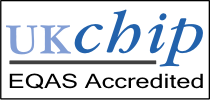
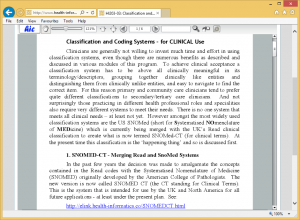

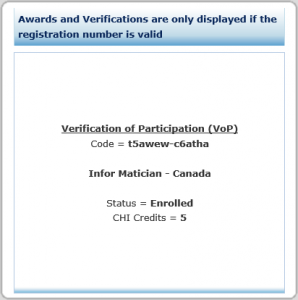
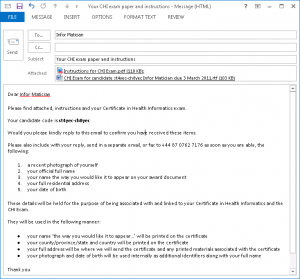
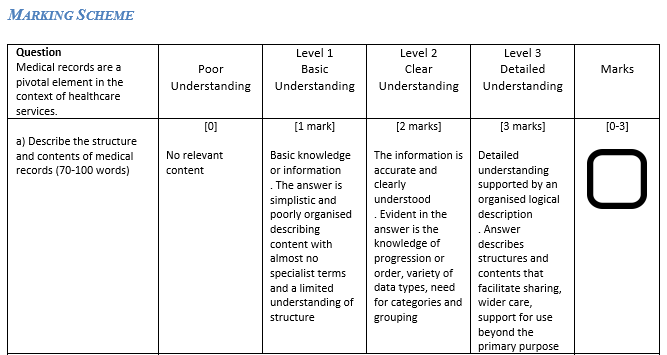
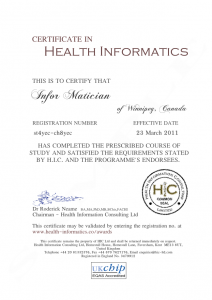
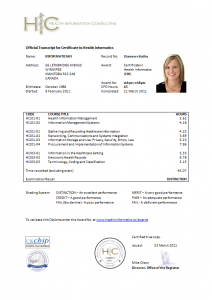
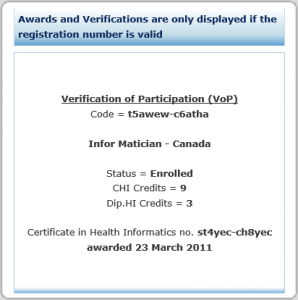
Is there a time limit within which each unit must be completed?
Do you offer training in other subjects?
What professional bodies recognise your diploma?
Are there any units that would not be relevant to Australia?
Hi Margaret – thank you for your enquiry
Time limits – you should study at your own pace. Whether you achieve the objectives quickly or slowly is entirely up to you. The educational purpose is served regardless of how slowly or quickly you master the program materials.
Relevance to Australia – many of the examples cited are from Australia, and the program is just as relevant to Australia and New Zealand as to North America, Canada and Europe. They all face essentially the same issues, the technical and professional challenges are the same, there are minor differences in procedures and legislation, but these are addressed in the materials. So all the materials are as relevant.
Other training – Yes, we have complementary Health Informatics programmes in Information Governance, Ethics and the Law, a complete online problem-based pre-clinical medical education programme and for the younger initiates, a higher national certificate and diploma programme too. These are currently only available through our licensed tertiary education partners.
Accreditations – please visit http://www.health-informatician.com/category/accreditation-2/
We look forward to seeing you online!
Hi!
Please i am ready to sit for CHI Exams… How do i go about it? Can you send me an email concerning that?
Thank you
Pingback: If I do this course will it help me get ukchip registration?
I need job
Hi Afzal
We took the liberty of perusing your CV and see that you have many years of experience as a health informatician working within the industry.
Like many, your knowledge and understanding of health informatics has come about through practical application and involvement.
Now is certainly the time to add qualifications to your CV and to enhance your profile with professional membership of UKCHIP.
We suggest you skip the CHI and start the Diploma in Health Informatics (DipHI) by clicking http://www.health-informatics.co/m/course/view.php?id=2
You can study the first 3 DipHI courses for free before registering for the full 17 week programme.
UKCHIP will award a year’s free membership to you when you successfully complete HIC’s Diploma in Health Informatics and with your experience (and the assumption that you pass with good grades), we will sponsor your application for Level 1 membership (which means you may add the ‘UKCHIP Registered Professional’ logo to your email signature) and you will be able to add one of our Directors names as an academic reference to your CV.
This in addition to your qualification being displayed on our ‘Roll of Honour’ awards page.
Several Universities recognise the quality of our programmes by endorsing, providing cross-credits or granting ‘rights of entry’ or ‘pre-requisite waivers’ to their Master’s in Health Informatics degree courses. See http://www.health-informatician.com/category/accreditation-2/ More will be added in the forthcoming months.
We look forward to seeing you join us online.
Registrar’s Assistant – Jo
I need information for the certificate and diploma programmes in health information
Hi Yasir
Thank you for getting in touch.
Fees and more detail about each qualification are presented on these pages:
• CHI – http://www.health-informatician.com/certificate-in-health-informatics-chi/
• DipHI – http://www.health-informatician.com/diploma-in-health-informatics-diphi/
• Fees – http://www.health-informatician.com/fee/
• Accreditations and onward progression with partner institutions – http://www.health-informatician.com/category/accreditation-2/
Our aims are 1) to educate, 2) to provide qualifications and 3) to create for our alumni (a somewhat exclusive assemblage of health informaticians) benefits specific to their needs.
To educate, we encourage all to study the first nine courses in their own time for free and without obligation. Try HI101-01 (for the CHI) http://www.health-informatics.co/m/course/view.php?id=7 and/or HI203-01 (for the DipHI) http://www.health-informatics.co/m/course/view.php?id=2
Our CHI and DipHI qualifications are accredited by the UK Council for Health Informatics Professions and those who pass our exams are rewarded with their first year’s UKCHIP membership (associate or Level 1) for free.
We have a good number (000’s) of students and alumni now for what is a field which is still very much new and unknown to most (even those in the industry).
This means we can now concentrate on expanding our courseware materials and on providing more resources and tailored benefits to our assembly.
We look forward to seeing you progress online.